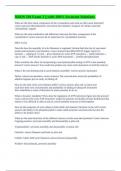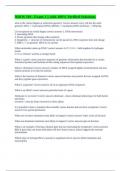Nros 310 - Study guides, Class notes & Summaries
Looking for the best study guides, study notes and summaries about Nros 310? On this page you'll find 72 study documents about Nros 310.
All 72 results
Sort by

-
NROS 310 Exam 2 || with 100% Correct Answers.
- Exam (elaborations) • 28 pages • 2024
-
Available in package deal
-
- $13.99
- + learn more
Where does translation always start? correct answers cytoplasm Do proteins destined for the nucleus (eg TF) also get translated in the cytoplasm? correct answers Yes, they must exit the nucleus to get translated and then get transported back into the nucleus What strategies do you think the cell can use to get proteins to the right place within the cell? correct answers - protein tagging What mechanisms do cells use to transport proteins to the right place within the cell? correct answe...

-
NROS 310 Exam 3 FINAL || very Flawless.
- Exam (elaborations) • 15 pages • 2024
-
Available in package deal
-
- $12.49
- + learn more
What are the three main components of the cytoskeleton and what are their main functions? correct answers Microtubules, microfilaments and intermediate filaments that help form the cytoskeleton to create stability, structure, and allow movement What are the main similarities and differences between the three components of the cytoskeleton? correct answers Microfilaments: flexible, smallest, regulate motion, help stabilize, polymerized from monomers to polymers Microtubules: less flexible, ...

-
NROS 310 Exam 3 || A+ Graded Already.
- Exam (elaborations) • 14 pages • 2024
-
Available in package deal
-
- $11.99
- + learn more
Cytoskeleton: A) 3 main components B) main functions correct answers A) actin filaments, microtubules, and intermediate filaments B) actin - sense the environment and direct movement microtubules - for transport intermediate - help keep the cell shape, to anchor organelles What are the main similarities and differences between the three components of the cytoskeleton? correct answers Main similarities: - all important for cytoskeleton structure - MT & Fila: charged ends; form a...

-
NROS 310 Exam 2 Study Sets || All Answers Are Correct 100%.
- Exam (elaborations) • 13 pages • 2024
-
Available in package deal
-
- $11.79
- + learn more
Why is it important that proteins get targeted to the right cellular location? (11) correct answers Each protein has a specific function at its intended destination in the cell and failing to complete that task can result in the cell not functioning properly. Ex. in cystic fibrosis the CFTR protein is not able to reach the membrane leading to fluid buildup in the lungs. How do proteins get to the appropriate targets within the cell? (11) correct answers Specific sequences of amino acids can s...

-
NROS 310 - EXAM 2 || with 100% Errorless Answers.
- Exam (elaborations) • 10 pages • 2024
-
Available in package deal
-
- $11.29
- + learn more
describe the signals and mechanisms required for import into the peroxisome correct answers peroxisomal matrix proteins have targeting sequences which are recognized by Pex5 receptor and brought to peroxisomal matrix what is a peroxisome? correct answers organelles that carries out redox reactions to clean out the cell (neutralizes waste) Describe the functions of SRP. correct answers brings ribosome to protein translocator and docks it on ER membrane How do multiple transmembrane prote...

-
NROS 310 Exam 3 || with 100% Accurate Solutions.
- Exam (elaborations) • 10 pages • 2024
-
Available in package deal
-
- $11.49
- + learn more
What are the three main components of the cytoskeleton and what are their main functions? correct answers Microfilaments: movement microtubules: transport of cellular materials intermediate: support What are the main similarities and differences between the three components of the cytoskeleton? correct answers all are important for cytoskeleton structure differ in size Describe how the assembly of actin filaments is regulated. Include both the role of associated protein and monomer co...

-
NROS 310 - Exam 1 || with 100% Verified Solutions.
- Exam (elaborations) • 10 pages • 2024
-
Available in package deal
-
- $11.49
- + learn more
what is the central dogma or molecular genetics? correct answers every cell has the same genomic DNA -> transciption (DNA-mRNA) -> translation (RNA-proteins) -> offspring List exceptions to central dogma correct answers 1. RNA/retroviruses 2. noncoding DNA 3. Prions (proteins that change other proteins) 4. Epigenetic -> structure of chromosome can be passed on, DNA sequence does not change 5. RBC's -> no genomic DNA bc no nucleus What nucleotides make up DNA? correc...

-
NROS 310 Exam 3 Study Questions || with 100% Errorless Solutions.
- Exam (elaborations) • 10 pages • 2024
-
Available in package deal
-
- $11.49
- + learn more
Describe endocrine, paracrine, and autocrine signaling. correct answers Endocrine: An endocrine cell releases a hormone into the blood stream to target a receptor on the target cell. Paracrine: A signaling cell releases a local mediator to target cells (neighboring cells). Autocrine: A cell releases a chemical signal to target itself. How does a hormone that is released generally throughout the body end up having different effects on (or no effects on) different cells? correct answers H...
NROS 310 Final Exam 2023 with 100% correct answers

-
NROS 310 Final Exam || with A+ Guaranteed Solutions.
- Exam (elaborations) • 9 pages • 2024
-
Available in package deal
-
- $11.19
- + learn more
Gene correct answers The sequence of genomic DNA that codes for a functional product and all necessary elements to properly regulate its expression What is the most likely type of biochemical change in a protein that results in a recessive and dominant mutation correct answers recessive: Changes in protein that results in a loss of function Dominant: Changes in proteins that result in a gain of functional Describe how a transcriptional activator can have both short term and long term eff...

$6.50 for your textbook summary multiplied by 100 fellow students... Do the math: that's a lot of money! Don't be a thief of your own wallet and start uploading yours now. Discover all about earning on Stuvia



